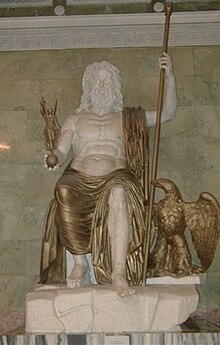The seated statue, some 12 metres (43 feet) tall, occupied half of the width of the aisle of the temple built to house it. "It seems that if Zeus were to stand up," the geographer Strabo noted early in the 1st century BC, "he would unroof the temple."[2] The Zeus was a chryselephantine sculpture, made of ivory and gold-plated bronze. No copy in marble or bronze has survived, though there are recognizable but approximate versions on coins of nearby Elis and on Roman coins and engraved gems.[3] A very detailed description of the sculpture and its throne was recorded by the traveler Pausanias, in the 2nd century AD. The sculpture was wreathed with shoots of olive worked in gold and seated on a magnificent throne of cedarwood, inlaid with ivory, gold, ebony and precious stones. In Zeus' right hand there was a small statue of crowned Nike, goddess of victory, also chryselephantine, and in his left hand, a sceptre inlaid with gold, on which an eagle perched.[4] Plutarch, in his Life of the Roman general Aemilius Paulus, records that the victor over Macedon, when he beheld the statue, “was moved to his soul, as if he had seen the god in person,” while the 1st century AD Greek orator Dio Chrysostom declared that a single glimpse of the statue would make a man forget all his earthly troubles.[5]

The date of the statue, in the third quarter of the 5th century BC, long a subject of debate, was confirmed archaeologically by the rediscovery and excavation of Phidias' workshop.
According to a legend, when Phidias was asked what inspired him—whether he climbed Mount Olympus to see Zeus, or whether Zeus came down from Olympus so that Pheidias could see him—the artist answered that he portrayed Zeus according to Book One, verses 528 – 530 of Homer's Iliad: [6]

Roman Seated Zeus, marble and bronze (restored), following the type established by Phidias (Hermitage Museum)
According to a legend, when Phidias was asked what inspired him—whether he climbed Mount Olympus to see Zeus, or whether Zeus came down from Olympus so that Pheidias could see him—the artist answered that he portrayed Zeus according to Book One, verses 528 – 530 of Homer's Iliad: [6]
-
- ἦ καὶ κυανέῃσιν ἐπ' ὀφρύσι νεῦσε Κρονίων
- ἀμβρόσιαι δ' ἄρα χαῖται ἐπερρώσαντο ἄνακτος
- κρατὸς ἀπ' ἀθανάτοιο μέγαν δ' ἐλέλιξεν Ὄλυμπον.
-
- He spoke, the son of Kronos, and nodded his head with the dark brows,
- and the immortally anointed hair of the great god
- swept from his divine head, and all Olympos was shaken.[7]


No comments:
Post a Comment